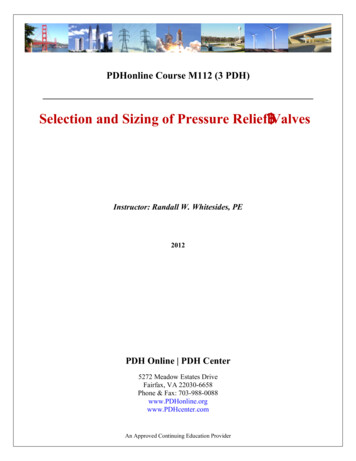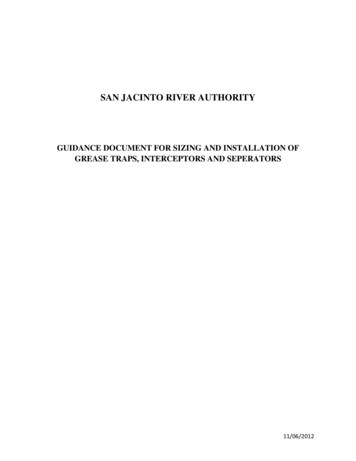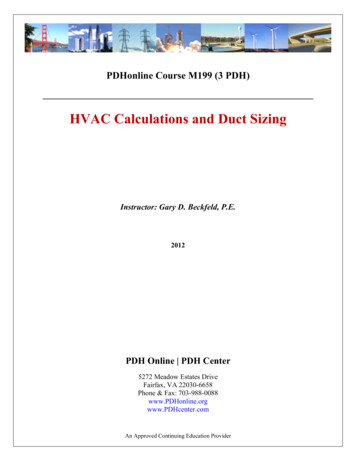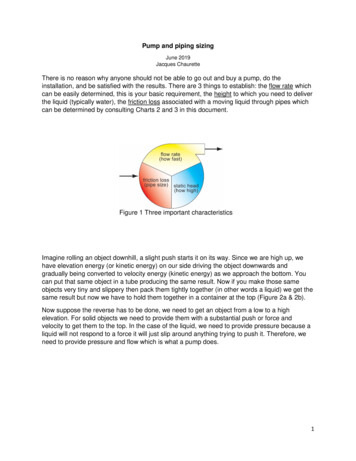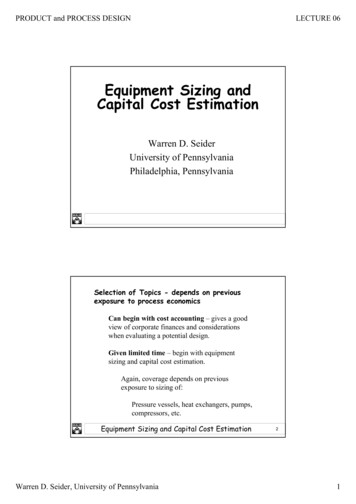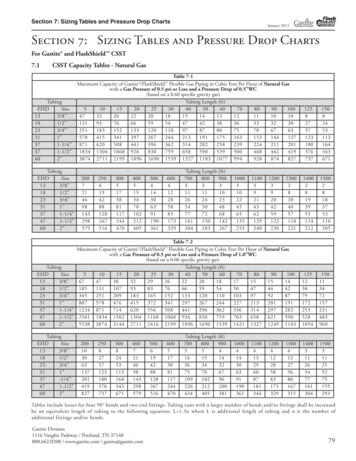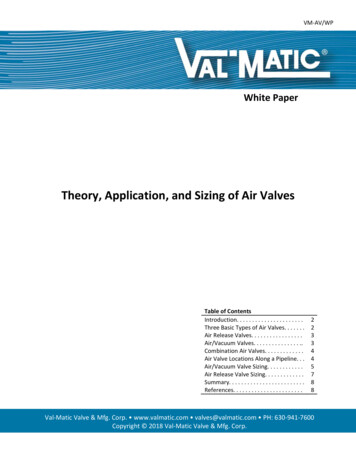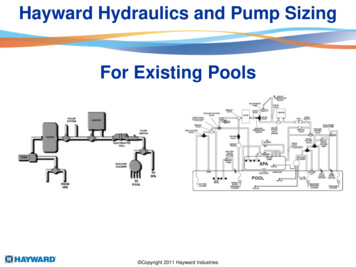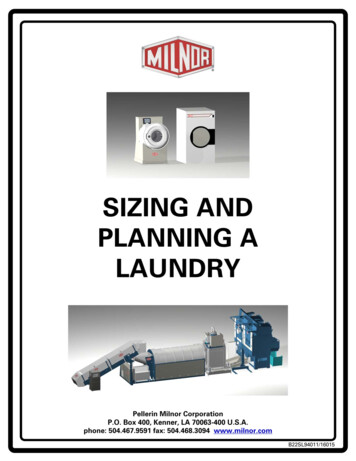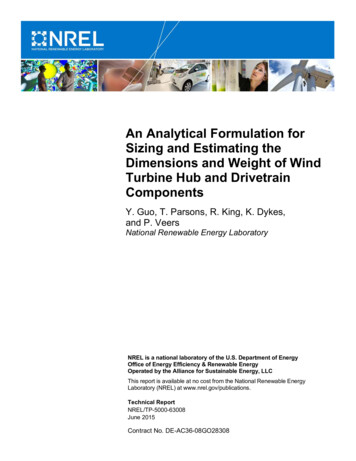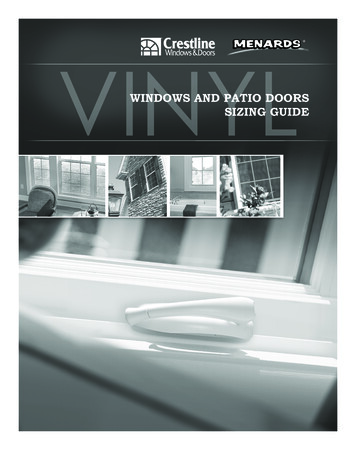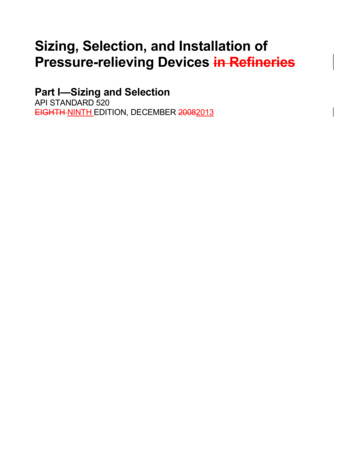
Transcription
Sizing, Selection, and Installation ofPressure-relieving Devices in RefineriesPart I—Sizing and SelectionAPI STANDARD 520EIGHTH NINTH EDITION, DECEMBER 20082013
2API STANDARD 520, PART 1—SIZING AND SELECTIONSizing, Selection, and Installationof Pressure-relieving Devices in RefineriesPart I—Sizing and SelectionDownstream SegmentAPI STANDARD 520EIGHTH NINTH EDITION, DECEMBER 20082013
SIZING, SELECTION, AND INSTALLATION OF PRESSURE-RELIEVING DEVICES IN REFINERIES3ForewordAPI Standard 520, Sizing, Selection, and Installation of Pressure-relieving Devices in Refineries, is the result ofseveral years' work by engineers in the petroleum industry. The information in this standard is intended to supplementthe information contained in Section VIII—Pressure Vessels, of the ASME Boiler and Pressure Vessel Code. Therecommendations presented in this publication are not intended to supersede applicable laws and regulations.Users of this standard are reminded that no publication of this type can be complete, nor can any written document besubstituted for qualified engineering analysis.Shall: As used in a standard, “shall” denotes a minimum requirement in order to conform to the specification.Should: As used in a standard, “should” denotes a recommendation or that which is advised but not required in orderto conform to the specification.The current edition of this standard, published in two parts, has been updated with respect to the practices generallyused in the installation of all devices covered in the previous editions; the current edition also contains additionalinformation based on revisions suggested by many individuals and several organizations.The 1st Edition of this standard was initially released as a recommended practice in 1955. The 2nd Edition waspublished in two parts: Part I, Design, in 1960 and Part II, Installation, in 1963. The 3rd Edition of Part I was issued inNovember 1967 and reaffirmed in 1973. The 4th edition was issued in December 1976, the 5th Edition was issued inthJuly 1990, the 6th Edition was issued in March 1993, and the 7th Edition was issued in January 2000 and the 8Edition was issued in December 2008.API publications may be used by anyone desiring to do so. Every effort has been made by the Institute to assure theaccuracy and reliability of the data contained in them; however, the Institute makes no representation, warranty, orguarantee in connection with this publication and hereby expressly disclaims any liability or responsibility for loss ordamage resulting from its use or for the violation of any federal, state, or municipal regulation with which thispublication may conflict.Nothing contained in any API publication is to be construed as granting any right, by implication or otherwise, for themanufacture, sale, or use of any method, apparatus, or product covered by letters patent. Neither should anythingcontained in the publication be construed as insuring anyone against liability for infringement of letters patent.This document was produced under API standardization procedures that ensure appropriate notification andparticipation in the developmental process and is designated as an API standard. Questions concerning theinterpretation of the content of this publication or comments and questions concerning the procedures under which thispublication was developed should be directed in writing to the Director of Standards, American Petroleum Institute,1220 L Street, N.W., Washington, D.C. 20005. Requests for permission to reproduce or translate all or any part of thematerial published herein should also be addressed to the director.Generally, API standards are reviewed and revised, reaffirmed, or withdrawn at least every five years. A one-timeextension of up to two years may be added to this review cycle. Status of the publication can be ascertained from theAPI Standards Department, telephone (202) 682-8000. A catalog of API publications and materials is publishedannually and updated quarterly by API, 1220 L Street, N.W., Washington, D.C. 20005.Suggested revisions are invited and should be submitted to the Downstream Segment, API, 1220 L Street, NW,Washington, D.C. 20005, standards@api.org.
4API STANDARD 520, PART 1—SIZING AND SELECTIONSizing, Selection, and Installation of Pressure-relieving Devices in RefineriesPart I—Sizing and Selection1ScopeThis standard applies to the sizing and selection of pressure relief devices used in refineries, chemical facilities andrelated industries for equipment that has a maximum allowable working pressure of 15 psig (103 kPag) or greater. Thepressure relief devices covered in this standard are intended to protect unfired pressure vessels and relatedequipment against overpressure from operating and fire contingencies.This standard includes basic definitions and information about the operational characteristics and applications of variouspressure relief devices. It also includes sizing procedures and methods based on steady state flow of Newtonian fluids.Pressure relief devices protect a vessel against overpressure only; they do not protect against structural failure whenthe vessel is exposed to extremely high temperatures such as during a fire. See API Std 521 for information aboutappropriate ways of reducing pressure and restricting heat input.Atmospheric and low-pressure storage tanks covered in API Std 2000 and pressure vessels used for thetransportation of products in bulk or shipping containers are not within the scope of this standard.The rules for overpressure protection of fired vessels are provided in ASME Section I and ASME B31.1, and are notwithin the scope of this standard.2Normative ReferencesThe following referenced documents are cited in this document for informational purposes. For dated references, onlythe edition cited applies. For undated references, the latest edition of the referenced document (including anyamendments) applies.API StdRP 520, Sizing, Selection, and Installation of Pressure-relieving Devices in Refineries, Part II—InstallationAPI Std 521/ISO 23251, Guide for Pressure-relieving and Depressuring SystemsAPI Std 526, Flanged Steel Pressure Relief ValvesAPI Std 527, Seat Tightness of Pressure Relief ValvesAPI Std 2000, Venting Atmospheric and Low-pressure Storage Tanks: Nonrefrigerated and Refrigerated1ASME Boiler and Pressure Vessel Code , Section I—Power BoilersASME Boiler and Pressure Vessel Code, Section VIII—Pressure Vessels, Division 12ASME BPVC Code Case 2091-3 , Nonreclosing Pin Pressure Relief Devices3ASME BPVC Code Case 2203 , Omission of Lifting Device Requirements for Pressure Relief Valves on Air, WaterOver 140 F, or Steam ServiceASME BPVC Code Case 2487, Breaking Pin Pressure Relief Devices123ASME International, 3 Park Avenue, New York, New York 10016, www.asme.org.Code Cases are temporary in nature and may not be acceptable in all jurisdictions. The user should verify the currentapplicability of the referenced Code Cases.Code Cases are temporary in nature and may not be acceptable in all jurisdictions. The user should verify the currentapplicability of the referenced Code Cases.
SIZING, SELECTION, AND INSTALLATION OF PRESSURE-RELIEVING DEVICES IN REFINERIES5ASME B31.1, Power PipingASME B31.31, Process PipingASME PTC 25, Pressure Relief Devices3Terms and DefinitionsFor the purposes of this document, the following definitions apply. Many of the terms and definitions are taken fromASME PTC 25.3.1accumulationThe pressure increase over the maximum allowable working pressure of the vessel, expressed in pressure units or asa percentage of maximum allowable working pressure (MAWP) or design pressure. Maximum allowableaccumulations are established by applicable codes for emergency operating and fire contingencies.3.2actual discharge areaactual orifice areaThe area of a pressure relief valve (PRV) is the minimum net area that determines the flow through a valve.3.3backpressureThe pressure that exists at the outlet of a pressure relief device as a result of the pressure in the discharge system.Backpressure is the sum of the superimposed and built-up backpressures.3.4balanced pressure relief valveA spring-loaded pressure relief valve that incorporates a bellows or other means for minimizing the effect ofbackpressure on the operational characteristics of the valve.3.5blowdownThe difference between the set pressure and the closing pressure of a pressure relief valve, expressed as apercentage of the set pressure or in pressure units.3.6bore areanozzle areanozzle throat areathroat areaThe minimum cross-sectional flow area of a nozzle in a pressure relief valve.3.7built-up backpressureThe increase in pressure at the outlet of a pressure relief device that develops as a result of flow after the pressurerelief device opens.3.8burst pressureThe value of the upstream static pressure minus the value of the downstream static pressure just prior to when the diskbursts. When the downstream pressure is atmospheric, the burst pressure is the upstream static gauge pressure.3.9burst pressure toleranceThe variation around the marked burst pressure at the specified disk temperature in which a rupture disk shall burst.
6API STANDARD 520, PART 1—SIZING AND SELECTION3.10capacityThe rated capacity of steam, air, gas or water as required by the applicable code.3.11chatterChattering is where the PRV opens and closes at a very high frequency (on the order of the natural frequency of thevalve’s spring mass system). Spring loaded PRVs are mass-spring devices and consequently are susceptible todynamic interaction with the system.3.11closing pressureThe value of decreasing inlet static pressure at which the valve disc reestablishes contact with the seat or at which liftbecomes zero as determined by seeing, feeling or hearing.3.12coefficient of dischargeThe ratio of the mass flow rate in a valve to that of an ideal nozzle. The coefficient of discharge is used for calculatingflow through a pressure relief device.3.13cold differential test pressureThe pressure at which a pressure relief valve is adjusted to open on the test stand. The cold differential test pressureincludes corrections for the service conditions of backpressure or temperature or both.3.14conventional pressure relief valveA spring-loaded pressure relief valve whose operational characteristics are directly affected by changes in thebackpressure.3.15curtain areaThe area of the cylindrical or conical discharge opening between the seating surfaces above the nozzle seat createdby the lift of the disc.3.16CyclingCycling is the relatively low frequency (a few cycles per second) opening and closing of a relief valve.3.16design pressurePressure, together with the design temperature, used to determine the minimum permissible thickness or physicalcharacteristic of each vessel component as determined by the vessel design rules. The design pressure is selected bythe user to provide a suitable margin above the most severe pressure expected during normal operation at acoincident temperature. It is the pressure specified on the purchase order. This pressure may be used in place of themaximum allowable working pressure (MAWP) in all cases where the MAWP has not been established. The designpressure is equal to or less than the MAWP.3.17effective coefficient of dischargeA nominal value used with an effective discharge area to calculate the relieving capacity of a pressure relief valve perthe preliminary sizing equations.
SIZING, SELECTION, AND INSTALLATION OF PRESSURE-RELIEVING DEVICES IN REFINERIES73.18effective discharge areaeffective orifice areaA nominal area used with an effective discharge coefficient to calculate the relieving capacity of a pressure relief valveper the preliminary sizing equations. API 526 provides effective discharge areas for a range of sizes in terms of letterdesignations, “D” through “T.”3.19FlutterFluttering is where the PRV is open but the dynamics of the system cause abnormal, rapid reciprocatingmotion of the moveable parts of the PRV. During the fluttering, the disk does not contact the seat butreciprocates at the frequency of the flutter.3.19huddling chamberAn annular chamber located downstream of the seat of a pressure relief valve for the purpose of assisting the valve toachieve lift.3.20inlet sizeThe nominal pipe size (NPS) of the device at the inlet connection, unless otherwise designated.3.21leak-test pressureThe specified inlet static pressure at which a seat leak test is performed.3.22liftThe actual travel of the disc from the closed position when a valve is relieving.3.23lot of rupture disksDisks manufactured at the same time and of the same size, material, thickness, type, heat and manufacturingprocess, including heat treatment.3.24manufacturing design rangeThe pressure range in which the rupture disk shall be marked. Manufacturing design ranges are usually catalogued bythe manufacturer as a percentage of the specified burst pressure. Catalogued manufacturing design ranges may bemodified by agreement between the user and the manufacturer.3.25marked burst pressurerated burst pressureThe burst pressure established by tests for the specified temperature and marked on the disk tag by the manufacturer.The marked burst pressure may be any pressure within the manufacturing design range unless otherwise specified bythe customer. The marked burst pressure is applied to all of the rupture disks of the same lot.3.26maximum allowable working pressureMAWPThe maximum gauge pressure permissible at the top of a completed vessel in its normal operating position at thedesignated coincident temperature specified for that pressure. The pressure is the least of the values for the internal orexternal pressure as determined by the vessel design rules for each element of the vessel using actual nominalthickness, exclusive of additional metal thickness allowed for corrosion and loadings other than pressure. Themaximum allowable working pressure is the basis for the pressure setting
API Standard 520, Sizing, Selection, and Installation of Pressure-relieving Devices in Refineries, is the result of several years' work by engineers in the petroleum industry. The information in this standard is intended to supplement the information contained in Section VIII—Pressure Vessels, of the ASME Boiler and Pressure Vessel Code.File Size: 1MBPage Count: 112
